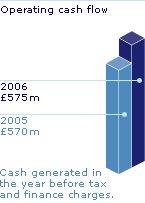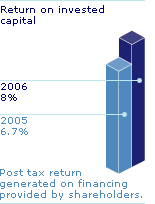Menu Links
About Pearson
Pearson is an international media and education company with world-leading businesses in education, business information and consumer publishing.
We create and manage intellectual property, which we promote and sell to our customers under well-known brand names, to inform, educate and entertain. We deliver our content in a variety of forms and through a variety of channels, including books, newspapers and online services. We increasingly offer services as well as content, from test administration and processing to teacher development and school software.
Though we operate in more than 50 countries around the world, today our largest markets are the US (65% of sales) and Europe (25% of sales).
Our businesses
Pearson consists of three major worldwide businesses:
Pearson Education is the world's leading education company. We are a leading publisher of textbooks, supplementary learning materials and electronic education programmes for teachers and students of all ages, and we play a major role in the testing and certification of school students and professionals. Pearson Education operates through three worldwide segments, serving School, Higher Education and Professional markets.
The Financial Times Group is a leading provider of international business and financial news, data, comment and analysis, in print and online. It has two major parts:
- FT Publishing includes the Financial Times and FT.com, one of the world's premier sources of business information, alongside our network of national business newspapers, financial magazines and online financial information companies.
- Interactive Data Corporation (IDC) provides specialist financial data to financial institutions and retail investors. Pearson owns a 62% interest in IDC, which is publicly listed on the New York Stock Exchange (NYSE:IDCO).
The Penguin Group is one of the world's foremost English language publishers. We publish the works of many authors in an extensive portfolio of fiction, non-fiction and reference titles, under imprints including Penguin, Hamish Hamilton, Putnam, Berkley,Viking and Dorling Kindersley.
Our strategy
Over the past decade we have transformed Pearson by focusing on companies which provide 'education' in the broadest sense of the word; companies that educate, inform and entertain. Through a combination of organic investment and acquisitions, we have built each one of our businesses into a leader in its market, and we have integrated our operations so that our businesses can share assets, brands, processes, facilities, technology and central services.
Our goal is to produce sustainable growth on our three key financial measures - adjusted earnings per share, cash generation and return on invested capital - which we believe are, together, good indicators that we are building the long-term value of Pearson.
We do this by investing consistently in four areas, which are common to all our businesses:
- Content We invest steadily in unique, valuable publishing content and keep replenishing it. Over the past five years, for example, we have invested $1.6bn in new content in our education business alone.
- Technology and services We invested early and consistently in technology, believing that, in the digital world, content alone would not be enough. In 2006, we generated more than $1bn in sales from technology products and services, and our testing and assessment businesses, serving school students and professionals,made more than $1bn of sales, up from around $200m seven years ago.
- International markets Though we currently generate two-thirds of our sales in the US, our brands, content and technology-plus-services models work around the world. All parts of Pearson are investing in selected emerging markets, where the demand for information and education is growing particularly fast.
- Efficiency We've invested to become a leaner, more efficient company, through savings in our individual businesses and through a strong centralised operations structure. Over the past five years, we have increased our profit margins from 9.9% to 13.4% and reduced average working capital as a percentage of sales in Pearson Education and Penguin from 30.7% to 26.3%, freeing up cash for further investment.
We believe this strategy can create a virtuous circle - efficiency, investment, market share gains and scale - which in turn can produce sustainable growth on our financial goals and the value of the company.
2006 financial overview
Pearson's three key financial measures are adjusted earnings per share, cash flow and return on invested capital. In 2006, adjusted EPS and cash flow reached record levels, and our return on invested capital increased from 6.7% in 2005 to 8.0%, above our weighted average cost of capital of 7.7%.
Pearson's sales increased by 4% to £4.4bn and adjusted operating profit was up 15% to a record £592m. All parts of Pearson contributed, with good sales growth, further margin improvement and double-digit profit increases in each business. Adjusted earnings per share were 40.2p, up 18%.
Operating cash flow increased by £5m to £575m and free cash flow by £2m to £433m. Cash conversion was strong at 97% of operating profit (even after an exceptional 113% cash conversion rate in 2005). The ratio of average working capital to sales at Pearson Education and Penguin improved by 1.1% points to 26.3%.
Statutory results show an increase in operating profit to £540m (£516m in 2005). Basic earnings per share were 55.9p (compared with 78.2p in 2005, which included the £302m profit on the sale of Recoletos). Net debt rose by £63m to £1,059m (from £996m in 2005).
During the year, we completed a series of bolt-on acquisitions in Education (including Promissor, Paravia Bruno Mondadori, National Evaluation Systems, PowerSchool and Chancery) and the FT Group (Quote.com and Mergermarket). Our total investment in acquisitions in 2006 was £363m. Together, these acquisitions contributed £147m of sales and £17m of operating profit to our 2006 results (after integration costs, which are expensed).
In December 2006 we announced the sale of Government Solutions to Veritas Capital for $560m in cash, $40m in preferred stock and a 10% interest in the company. In 2006 Government Solutions contributed £286m of sales and £22m of operating profit to Pearson. The sale was completed in February 2007. As part of our plan to reduce our UK pension deficit, we will inject £100m of the cash proceeds from the sale of Government Solutions into our UK Group pension plan during 2007.
Key Financial Measures and Performance Indicators




Note: throughout this review, we refer to a series of 'Key Performance Indicators' alongside our key financial measures. Management uses these Indicators to track performance on non-financial measures such as market share or growth relative to our industries.
The board is proposing a dividend increase of 8.5% to 29.3p, the largest increase for a decade. Subject to shareholder approval, 2006 will be Pearson's 15th straight year of increasing our dividend above the rate of inflation, and in the past five years alone we have returned approximately £1bn to shareholders through the dividend.
Pearson outlook 2007
We expect 2007 to be another good year for Pearson with continued margin improvement and growth ahead of our markets. We expect to achieve good underlying earnings growth, cash generation well ahead of our 80% threshold, and a further improvement in return on invested capital.
In 2007 we continue to invest in the growth and market-leading positions of our businesses, including:
- extending our lead in education, investing in new programmes for students in School and Higher Education and in testing and software services that help educators to personalise the learning process, both in the US and internationally;
- developing our fast-growing assessment businesses, which provide testing and related services to educational bodies;
- building the international reach of the Financial Times - both in print through its four editions worldwide and online through FT.com;
- developing a business concentrating on providing financial information services for financial institutions, corporations and their advisers;
- growing our position in consumer publishing, balancing our investment across our stable of bestselling authors, new talent and our own home-grown content.
